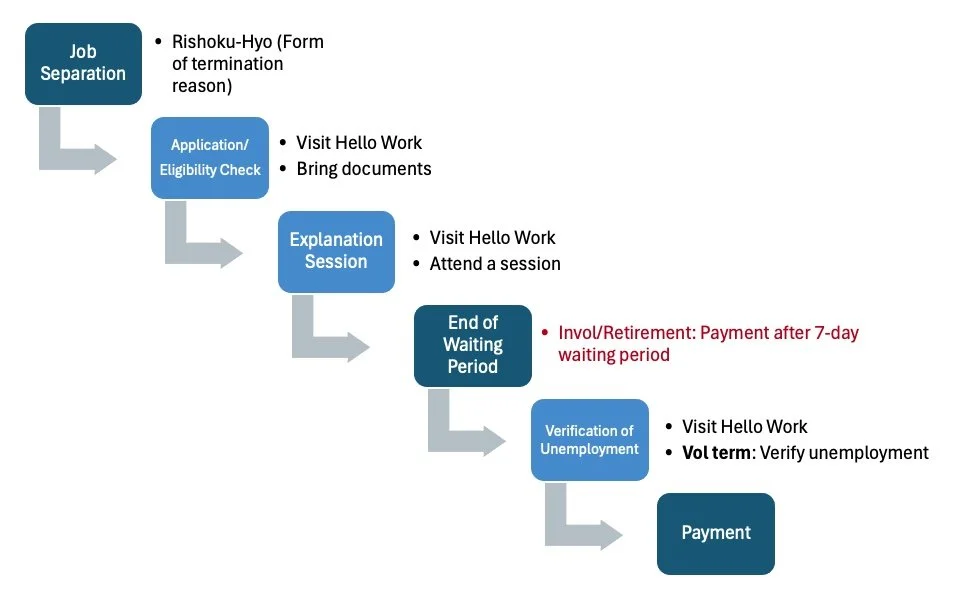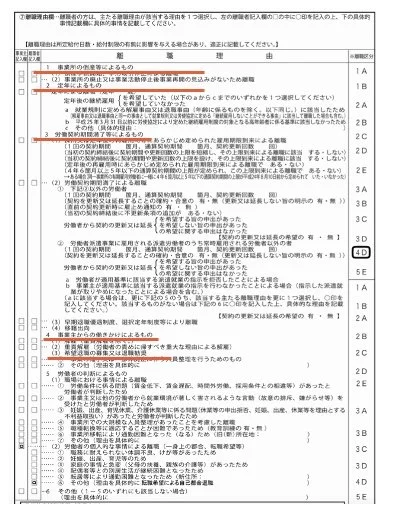Unemployment Benefits in Japan for Foreign Workers: Who Qualifies and How to Apply
At some point in your career, you may face job loss or a mid-career transition. In those moments, managing your income becomes a major concern — especially if you’re living abroad.
In Japan, unemployment doesn't just affect your finances; it can also impact your immigration status. That’s why it’s important to understand Japan’s unemployment insurance system (雇用保険, koyou hoken) — including who qualifies and how to apply.
The good news: foreign workers are covered under Japan’s unemployment insurance, as long as certain conditions are met. This guide explains how the system works and what to expect.
👉 Related posts:
What You’ll Learn:
What Is Unemployment Insurance in Japan?
Who’s Eligible?
How Much Do You Get?
Types of Unemployment & Payment Start
Application Process
Tips for Foreign Applicants
Common Challenges & Myths
Final Thoughts
1. What Is Unemployment Insurance in Japan?
Japan’s unemployment insurance helps workers who have lost their jobs or are attending government-approved vocational training. The system is designed to maintain financial stability while supporting reemployment.
If you work 20+ hours per week and are expected to be employed for at least 31 days, your employer is required to enroll you. Enrollment is typically handled by HR when you join a company. If you already have an employment insurance number from a previous job, make sure to submit it when onboarding.
Unlike in the U.S., Japan operates a nationally standardized system that emphasizes reemployment support, while the U.S. system varies by state and focuses more on short-term income replacement.
✅ While receiving benefits, you must actively seek employment and report activities regularly to Hello Work.
📚 Real Story:
An American IT support associate voluntarily resigned from his job after undergoing minor surgery. He planned to take a short career break but registered with Hello Work to qualify for unemployment benefits. He held a Spouse visa, which allowed him to work in Japan.
To meet the active job search requirement, he applied for two positions anyway that looked interesting — and to his surprise, one led to a job offer. The new role turned out to be a fit with a lighter workload.
Takeaway: Japan’s system may feel strict, but it works well when it comes to supporting reemployment, even for those who aren’t initially sure about returning to work right away.
2. Who’s Eligible?
Eligibility for unemployment benefits in Japan depends on several factors, including your employment history, visa status, and the reason for your job separation.
Basic Conditions:
Voluntary Resignation: You must have paid into employment insurance for at least 12 months within the past two years.
Involuntary Termination (layoff, non-renewal, company closure): You only need six months of insurance payments within the past year.
Foreign nationals are eligible as long as they hold a valid work visa (e.g., Engineer/Specialist in Humanities/International Services, Highly Skilled Professional, etc.).
⚠️ Visa Expiry Warning:
If your work visa expires while you're receiving unemployment benefits, you may lose eligibility—even if you meet all other conditions. Since you’re no longer employed, your original work visa cannot be renewed.
To continue receiving benefits, you must apply to change your visa status to either “Temporary Visitor” or “Designated Activities”. However, immigration authorities evaluate each case individually. If the change is not approved, you must leave Japan—and your benefits will be terminated.
Also eligible:
Part-time workers (20+ hours/week, 31+ days)
People 65+ (can apply for the Elderly Job Seeker Benefit)
Short-term workers (may get a Special Lump-Sum Benefit)
Not eligible (For instance):
If you already have a new job lined up
If you’re self-employed
Always check with Hello Work if you're unsure.
3. How Much Do You Get?
Your benefit amount is based on your average daily wage over the last six months before separation.
Most people receive 50–80% of their average daily wage.
Ages 60–64: slightly reduced (45–80%).
Payment duration: 90–330 days, depending on age and how long you’ve contributed (max 240 days for age 60–64).
The longer your insured employment history, the longer you may receive benefits. Employment periods across different jobs are combined (or carried over) for insurance eligibility.
For official details, see item ⑦ in this PDF from Japan’s Ministry of Health, Labour and Welfare:
👉 PDF Link
4. Types of Unemployment & When Payments Start
You have 1 year from the day after your separation to receive benefits, up to your eligible maximum days.
⚠️ Apply early — unused days cannot be claimed after the 1-year limit.
5. Application Process
The application process must begin with an in-person visit to Hello Work.
Step 1: Get Your Certificate of separation (Rishokuhyo/離職票)
Your employer or payroll vendor will send this after your official separation date (not your last working day). It typically takes about two weeks to arrive.
⚠️ If your separation was involuntary (Layoff, Resignation recommendation, non-renewal, company closure,)/retirement, make sure the reason is clearly indicated on the Certificate of separation. If your Certificate of separation incorrectly shows a “voluntary” reason, speak up. Your benefits and wait period will be affected.
✅ On the Certificate of separation /Rishokuhyo below, one of the following should be checked to indicate involuntary termination or retirement: 1. Company closure, 2. Retirement, 3. Non-renewal, 4-(3). Resignation recommendation
Step 2: Apply at Hello Work
Bring the following documents:
Residence card (在留カード)
MyNumber card or resident certificate with MyNumber
Rishokuhyō
Bank info
Recent photo (waived with MyNumber card)
Step 3: Attend Orientation & Consultation
A brief overview session, plus career guidance.
Step 4: End of Waiting Period
After 7 days, if you were laid off, not renewed, or retired, payments can begin.
Step 5: Verification of Unemployment – Maintain Eligibility
You must visit Hello Work every 4 weeks and report at least 2 valid job search activities, such as:
Applying for jobs
Attending job training
Consulting Hello Work staff
⚠️ Simply searching for jobs in the Hello Work database does not count as a valid job-seeking activity.
Once your unemployment status is verified and the full waiting period—applicable to both voluntarily separated individuals and those dismissed for cause—is complete, Hello Work will confirm the first payment date and amount.
Step 6: Receive Payment
Once certified, benefits are paid by bank transfer.
6. Tips for Foreign Applicants
Language
Not all Hello Work branches offer English. Bring a friend or interpreter if needed.
Visa Grace Period
Foreign nationals are not immediately subject to work visa cancellation upon resignation. You typically have a three-month grace period to either find a new job or apply to change your residence status.
If you fail to secure employment or update your visa within that time, your work visa may be revoked. Whether a visa change is granted is at the discretion of Immigration Services, and if not approved, your unemployment benefits will be cut off.
If you resigned due to involuntary reasons (e.g., company circumstances), you may be eligible for a “Designated Activities” visa to continue job hunting beyond 3 months.
Where to Look for Jobs
Hello Work offers support desks for foreign job seekers. However, many of the jobs they introduce fall into lower to mid-income brackets.
✅ TIP: If you’re aiming for higher-paying roles or positions in international companies, platforms like Indeed, LinkedIn, BizReach, or global recruiting agencies may be more effective.
Mandatory Immigration Notification
Within 14 days of separation, file a Contract Termination Notice.
Penalties for failure: up to ¥200,000 fine or 1-year imprisonment. It may also impact your next visa.
Other Essentials:
Request a 退職証明書 (Certificate of Separation) from HR for visa-related filings.
If leaving Japan, ask about Lump-Sum Pension Withdrawal, resident tax, and health insurance.
If changing jobs, apply for a 就労資格証明書 (Work Eligibility Certificate) to smooth the visa process.
🔗 For more information: Immigration Services Agency – Notification regarding contract institutions (MOJ)
7. Common Challenges & Myths
Challenge 1: My company forgot to enroll me in unemployment insurance.
Fact: You should immediately consult your local Hello Work office and submit a Notification of Acquisition of Employment Insurance Eligibility (雇用保険被保険者資格取得届). Even if enrollment was delayed, it is possible to retroactively join the insurance system.
⚠️ Note: This is a serious oversight by the employer. If such issues continue, it may be a red flag — and you might consider looking for a more reliable company.
Challenge 2: My company let me go but didn’t help me with reemployment.
Fact: Under Japan’s Guidelines for the Appropriate Management of Employment of Foreign Workers, employers are encouraged to assist foreign employees with reemployment if they are dismissed.
This support may include:
• Referring the individual to Hello Work
• Providing relevant job search information
• Offering interpretation or translation assistance for workers with limited Japanese ability
🛑 Note: These recommendations apply only in cases of involuntary termination. They do not apply to voluntary resignation or disciplinary termination.
⚠️ If your company fails to offer this support after involuntary termination, you can still go to Hello Work directly for assistance. However, be sure to keep clear records of your separation, as documentation may be required during the application process.
Myth 1: I can’t go back to my home country while receiving unemployment benefits. Fact: You can temporarily return to your home country while on benefits — but you must notify Hello Work in advance and stop receiving payments during your absence.
Unreported travel abroad is considered a violation and can disqualify you from further benefits.
Myth 2: Hello Work won’t help foreigners.
Fact: They will — but English support is limited and job options may be narrow. Go prepared.
Myth 3: “You can’t get benefits on a Spouse Visa.”
Fact: You can, as long as you’re working and enrolled in employment insurance. Visa-related confusion is that many foreign workers don’t realize their work visa can’t be renewed once unemployed. You must proactively change your status to continue receiving benefits.
Myth 4: My benefits will continue until I find a job — no matter how long it takes. Fact: Benefits are not unlimited. You can only receive payments for a maximum number of days(typically 90 to 330days), and only within one year from the day after your job separation.
8.Wrap up
Losing or changing a job is always stressful — especially in a foreign country. But Japan’s unemployment insurance system offers meaningful support if you know how to navigate it.
I still remember an American colleague who was visibly questioning his job and career. His motivation had clearly declined, and both his manager and I — in HR — did our best to help him re-engage. Ultimately, though, due to performance concerns, we had to recommend resignation.
He wasn’t surprised. He simply said, “I should have made the change earlier.”
He applied for benefits at Hello Work, took some time to reflect, and landed a great new job within three months — and even welcomed a baby shortly after.
Because the resignation was considered company-driven, and based on the company’s policy, he received:
Retirement allowance (退職金) — a standard company benefit available to all employees who leave,
Severance pay — an additional sum to support the transition when the company recommends resignation, and
Unemployment benefits — with only a 7-day waiting period, thanks to the company-driven reason.
Sometimes, what feels like an ending is actually the beginning of something better.
New places, new people, and new possibilities await. It’s an opportunity.
When one door closes, another opens.
Make sure to claim what you've earned — and move forward with confidence.
Curious about how Japan’s work and benefit systems really work?
Explore more practical guides at NavigatorJapan.com — and feel free to share your story or questions in the comments or through our Contact Us page !







